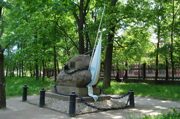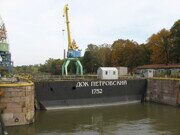Places of Interest
|
Anchors square is one of the most memorable places in Kronshtadt. Its name appeared in the XVIII century when the place was the depository of anchors and chains for ships. Anchors square ensemble includes a monument to the Great Russian naval commander, scientist and the head of Kronshtadt seaport - S. Makarov, which was established in July 1913. The sculptor of this monument is Z. Shervud. Besides, on the territory of Anchors square there are memorials to Revolution and Civil war victims and to Defenders of Kronshtadt and Leningrad in the Second World War. Near the Sovetskij Bridge there is "Oktyabrskaya Revolutsiya" - the memorial of a battleship. This monument includes the gun of I.Tambasov, piece of armour and 2 stem anchors of the ship.Сcast-iron roadway lies along the wall of the Dock Admiralty. |
|
 |
Naval Cathedral in the name of Saint Nicholas the Wonderworker >>>> |
 |
The Makarovsky Bridge was constructed to the opening of the Naval Cathedral. It is erected over the Petrovsky ravine which is one of the components of Peter the Great's dock built in 1752. |
|
In 1705 the house of Peter the Great was constructed on this area (not preserved). The first street of the town was in the Garden - Petrovskaya perspectiva. At the end of the XVIII century "Public Garden" was laid out here - the first town park named later as "Summer Garden". Nowadays several monuments to the courageous Russian sailors are placed inside. |
|
|
|
The most remarkable place of the park is a monument by T.Zhak to Peter the Great, the founder of Kronshtadt, installed in 1841.Petrovskaya pier, a memorial midday canon, a commemorative stele in honor of Russian sailors - heroes of Tcusima battle are situated on the embankment of the park. Near the east part of Petrovsky park the building of Marine Artillery Arsenal is situated. It was constructed according to the architect I.Gomzin's design in 1836. Originally it was a place for gun repairs, ship models and different combat trophies of the Russian fleet were stored there.
|
|
The unique hydro technical construction - the first dry dock in Russia - was built in 1719-1752 according to Peter the Great decree. It was intended for repairing underwater parts of ships and vessels. Its length is 300 m, width - 20 m and depth - 12 m. One of the oldest lighthouses in Kronshtadt is located on the shore of the Petrovsky Canal.Not far from the lighthouse a building of Dutch Kitchen is situated. It was absolutely forbidden to light fire on ships in the XVIII century so foreign and Russian cooks prepared meal for sailors in this kitchen. A memorable monument to 150-years of friendly relationships between Russia and Japan is installed on the west embankment of the Italian pond. The unique movable bridge is erected over the Petrovsky dock canal. |
|
| One of the main sights of the north embankment of Italian pond is Italian Palace of A.Menshikov erected in the first quarter of XVIII century by architect I.Braunshteyn's design. Italian masters took part in decoration works of the building. Naval Cadet School was located here from 1771 and later - Navigator and Engineer schools. Monument to P. Pakhtusov - outstanding explorer of New Land and Arctic Ocean - was introduced in 1886 in front of the Palace. Furthermore an exhibition of fortress and naval weapon being in service of fleet, forts and battery in XVIII - XIX centuries is situated on the Italian pond embankment from 2004. In 2007 next to Italian Palace garden a monument was installed to Ivan Aivazovskiy, a well-known marine painter. Aivazovskiy practiced in Kronshtadt and devoted a lot of his pictures to Kronshtadt seascapes. |
|
 |
Kronshtadt water gauge rod is a cast-iron ruler with marks fixed on the basis of Siniy Most (Blue Bridge). Absolute altitude of Earth surface, sea depth on navigation and topographic maps, space altitude are measured according to the Kronshtadt "null" level of water gauge rod. Pavilion of a tide gauge - a self registering device to measure Baltic Sea water level - is located on the canal bank near the water gauge rod. |
 |
This is a complex of buildings and constructions erected at the end of XVIII - the beginning of the XIX century for supplying the fleet ships and vessels with everything necessary.
|
|
A temple in the name of St. Andrew the First Called Apostle was built in 1817 in Kronshtadt by A. Zakharov and Ch. Kameron design. Ioann Sergiev (St. John of Kronshtadt) was a senior priest of the cathedral from 1855 till 1908. Unfortunately, the temple was razed to the ground in 1932. Now the place of the former cathedral marks a memorial stone. Nearby a memorial pedestrian zone is located. Here one can see a map of the city and symbolic pot from which according to a legend the Kotlin Island took its name. Situated opposite the pedestrian zone at the fence of Obvodny canal "Tree of desires" is very popular among young tourists and guests of the town. |
|
 |
In 1832 Gostiny Dvor - the main shopping centre of the town - was built by V.Maslov design. The building was completely reconstructed in 2007. To the south of Gostiny Dvor the musical fountain "Kronshlot" and a memorial sign to "300 years of Kronshtadt" were opened in 2004. |
 |
The Vladimir Icon of the Blessed Virgin Cathedral was built according to the architect H.Greyfan design in 1874. Nowadays inside the cathedral praying services are conducted. |
 |
Sea library (architect G.Kosyakov) is located in the town centre on the Soviet street. Built in the beginning of XX century this public library was considered to be the largest one in Russia at that time. |
 |
Officer outbuildings and Kronshtadt Sea Assembly - the oldest Sea Club in Russia - are situated in the Soviet street. In the park stretched along the street, monument to admiral and Kronshtadt military governor, the explorer of Antarctica - F. Bellingsgausen is situated. The monument-bust to the greatest scientist, physicist and Nobel laureate, an academician P. Kapitsa who was born in Kronshtadt is also presented here. |
|
Dated the first part of the XIX century the building of a former Lutheran church of St. Elizabeth (architect A.Anert and K. Beyl) is situated opposite the History Kronshtadt Museum. The church represents a rectangular building. Its main facade is decorated by a six-columned portico of the Corinthian warrant with a triangular pediment. Above altar part the high drum towered with dome and a cross which do not exist now. Now it is in charge of an association "Vodokanal".
|
|
 |
The vast territory in the south-east of the town is occupied by Sea Plant which functions more than 150 years. It is the first ship repair plant in Russia founded in 1858.Military ships and auxiliary vessels of domestic fleet were built and repaired in its shop floors and docks for many years. In severe years of the war and blockade, under bombardments and artillery shellings, plant workers consistently carried out all production targets. The memorable stele by sculptor V. Anufriev was established to honor them in 1967 on Metallistov park. |














